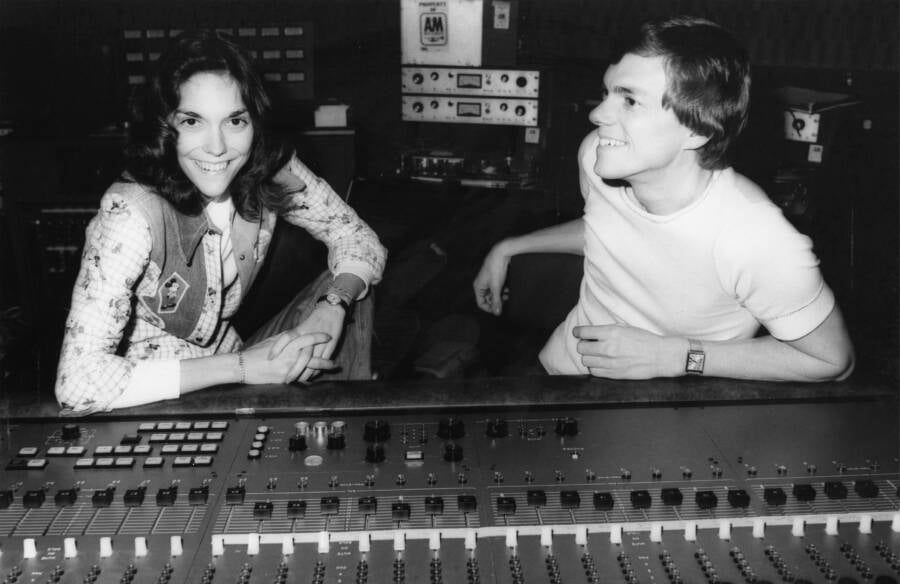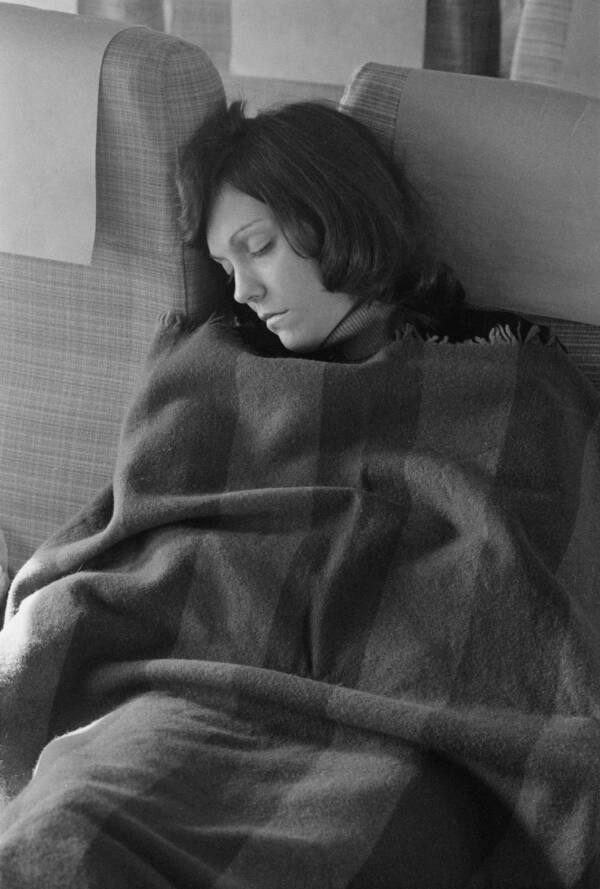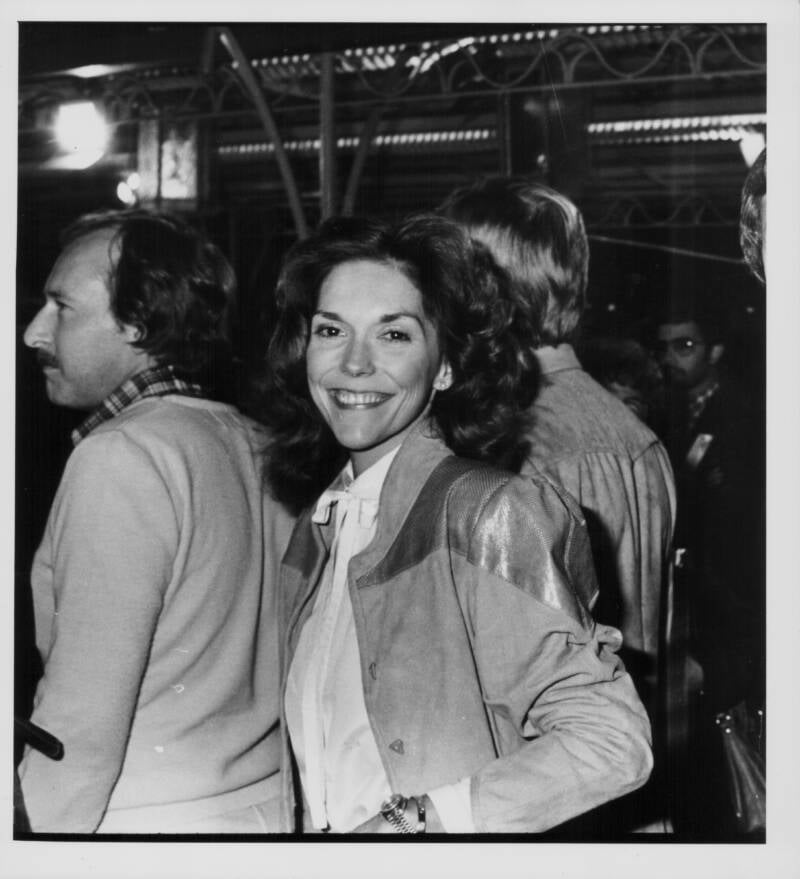Karen Carpenter died on February 4, 1983, after steadily poisoning herself with ipecac syrup, which she was using to try to maintain her weight while struggling with an eating disorder.
Warning: This article contains graphic descriptions and/or images of violent, disturbing, or otherwise potentially distressing events.

Hulton Archive/Getty ImagesKaren Carpenter’s death at the age of 32 shocked her fans and loved ones.
From the outside, Karen Carpenter looked like a rock star. She played the drums as one half of the band The Carpenters and had what Paul McCartney called “the best female voice in the world.” But away from prying eyes, she struggled with body image issues. Karen Carpenter’s death in 1983 marked a tragic conclusion to her struggle with anorexia nervosa.
By that point, Karen’s anorexia had dovetailed with her rise to fame. She and her brother, Richard, had charmed the nation as the sibling duo behind The Carpenters, but their stardom came at a steep price. Karen, unhappy with how she looked, turned to extreme measures to lose weight.
She hired a personal trainer, meticulously counted calories, and stopped eating altogether. Her weight plummeted to 90 pounds, concerning her fans and family alike. But though Karen sought medical and therapeutic help over the years, she continued to struggle with her eating disorder.
By the 1980s, Karen seemed happier and healthier but had secretly turned to even more extreme measures to avoid gaining weight. Unbeknownst to her doctors or loved ones, she’d started taking daily doses of ipecac syrup, which induces vomiting. It slowly ate away at her heart.
And on Feb. 4, 1983, Karen Carpenter died at the age of 32. Her official cause of death was “emetine cardiotoxicity due to or as a consequence of anorexia nervosa.” In other words, Karen, in her desperate battle with her eating disorder, had accidentally poisoned herself to death with ipecac syrup.
Inside The Rise Of The Carpenters

Michael Ochs Archives/Getty ImagesRichard and Karen Carpenter as “The Carpenters” circa 1970.
Born on March 2, 1950, in New Haven, Connecticut, Karen Carpenter was surrounded by music from the beginning. NPR writes that Karen’s older brother Richard was a music prodigy, and People notes that Karen was able to teach herself percussion by playing chopsticks on barstools.
When their family moved from New Haven to Downey, California, in 1963, Richard and Karen sought to make it as musicians. They formed a trio with a friend — with Richard on keyboards and Karen on drums — and even won a “battle of the bands” at the Hollywood Bowl. When their music was deemed “too soft,” the trio became a sibling duo.
In 1970, Richard and Karen were signed to A&M Records as “The Carpenters.” This marked their rise to fame — but also the beginning of Karen’s anorexia.

Ron Howard/RedfernsKaren Carpenter singing circa 1971.
As The Guardian reports, Karen had turned to dieting before. After high school, she had used the Stillman water diet to drop 25 pounds. But in 1973, Karen allegedly saw a photo of herself taken at a concert that she found unflattering. She became determined that she needed to lose more weight.
Perhaps it seemed harmless to her at the time, but her subsequent eating disorder would lead to Karen Carpenter’s death a decade later.
Karen Carpenter’s Struggle With Anorexia
As The Carpenters became bigger and bigger following hits like “(They Long to Be) Close to You” (1970), “Rainy Days and Mondays” (1971), and “Top of the World” (1972), Karen Carpenter started to shrink.

Michael Ochs Archives/Getty ImagesKaren Carpenter accepting an award circa 1977.
After hiring and firing a personal trainer — she didn’t like how building muscles made her heavier — Karen started trying to lose weight on her own. She exercised with a hip cycle, counted calories, and mapped out her intake of food, according to The Guardian. Before long, she lost 20 pounds.
Though her friends and family praised how she looked, Karen wanted to lose even more weight. She started avoiding food altogether, concealing her eating disorder by moving the food around her plate as she talked, or offering tastes of her meals to others until there was nothing left for her.
Before long, Karen’s anorexia started to impact her music. The Guardian writes that audiences gasped when they saw her emaciated frame, and The New York Times recounts that The Carpenters had to cancel their European tour in 1975 because of Karen’s “nervous and physical exhaustion.”

Michael Putland/Getty ImagesKaren Carpenter sleeping while on tour in 1974. As she struggled with anorexia, those close to her noticed that she seemed unusually exhausted.
Despite the clear warning signs, Karen’s eating disorder only intensified. She turned to laxatives to lose weight — taking dozens at a time — and prompted concern from the public. In 1981, an interviewer even asked Karen about her eating disorder directly, though the singer demurred.
“No, I was just pooped,” Karen said. “I was tired out.”
By then, however, Karen seemed to know she needed to change. She left her husband, who some saw as abusive and after her money, and attended therapy in New York City. In September 1982, she was hospitalized after feeling dizzy, and seemed to improve under the close watch of doctors.
Returning to Los Angeles in December of that year, Karen seemed to finally be in a good place. People reports that she seemed energetic and happy, and was planning on writing her own songs for the first time.
“I have a lot of living left to do,” she told a friend, according to People.
Tragically, Karen Carpenter died just two weeks later.
How Karen Carpenter Died At The Age Of 32
On Feb. 4, 1983, Karen Carpenter woke up at her parent’s house in Downey, California. She went downstairs, turned on the coffeepot, and returned to her room. At around 9 a.m., according to People, Karen collapsed.

PA Images via Getty ImagesRichard and Karen Carpenter in 1981.
Her mother, Agnes, found Karen nude on the floor, her nightgown over her body as if she’d been about to get dressed. Though EMTs were able to detect a faint pulse, leading them to believe that The Carpenters singer had “a good chance to survive,” she suffered from cardiac arrest on the way to the hospital. Karen Carpenter died at 9:51 a.m. at the age of 32.
According to an autopsy report, the 5-foot-4 singer weighed just 108 pounds.
In March 1983, UPI reported that Karen Carpenter’s death was caused by “chemical imbalances associated with anorexia nervosa.” Specifically, she’d suffered from a condition called “emetine cardiotoxicity,” or a slow poisoning of the heart.
It revealed that Karen had been slowly poisoning herself with ipecac syrup, which induces vomiting (and is usually for poison or drug overdoses). It would have helped her maintain her weight, but at a price. The syrup also eats away at the heart muscles.
“I’m sure she thought this was a harmless thing she was doing, but in 60 days she had accidentally killed herself,” Steven Levenkron, a psychotherapist who’d treated Karen explained in a radio interview, according to The Guardian. “It was a shocker for all of us who treated her.”
The Aftermath Of Karen Carpenter’s Death

Frank Edwards/Archive Photos/Getty ImagesKaren Carpenter in 1980, a few years before she died at the age of 32.
Karen Carpenter’s death at the age of 32 brought new attention to anorexia, which most people at the time didn’t know much about.
“Anorexia nervosa was so new that I didn’t even know how to pronounce it until 1980,” The Carpenters band member John Bettis recalled, according to Time. “From the outside, the solution looks so simple. All a person has to do is eat. So we were constantly trying to shove food at Karen.”
Time notes that, in the era of Twiggy, Karen Carpenter’s death revealed that it was possible to be too thin. It also inspired doctors and therapists specializing in eating disorders to push the Food and Drug Administration to ban over-the-counter sales of ipecac syrup.
“We think 30,000 or more young girls are abusing a drug that was not known until very recently as an abusive drug,” Carpenter’s therapist, Levenkron, told The New York Times. He noted that some people consumed four bottles a day and estimated that “Between 50 and 250 bottles could be fatal.”
Karen Carpenter’s death also prompted many to ask why she had developed anorexia in the first place. Many have noted that anorexia is, at its roots, a method of control. Rumors suggested Karen had grown up with a controlling mother who doted on her brother, and that her brother controlled the trajectory of their band. Some have speculated that Karen started restricting her eating habits because it was the one thing she could manage herself.
Ultimately, Karen’s motivations remain known only to her. But what others have acknowledged repeatedly since her death is that Karen Carpenter was a singer taken too soon. She had, Paul McCartney declared according to NPR, “the best female voice in the world: melodic, tuneful and distinctive.”
Sadly, when Karen looked in the mirror, that wasn’t enough.
After reading about the death of Karen Carpenter, see how promising musician Jeff Buckley — known for his cover of Leonard Cohen’s “Hallelujah” — tragically died at the young age of 30. Or, go inside the sad story of Nirvana frontman Kurt Cobain’s 1994 suicide note.





